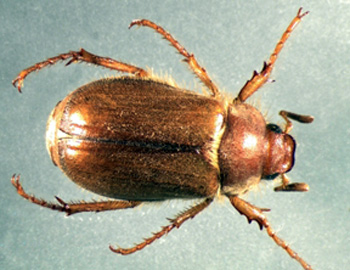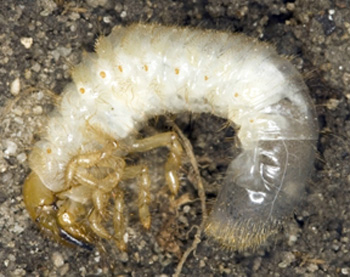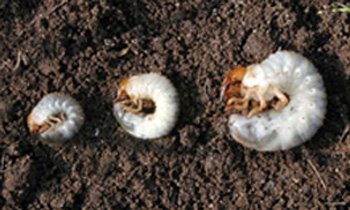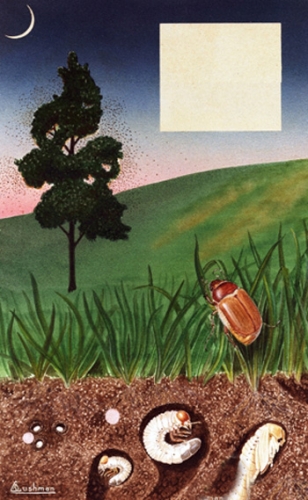Recent emergences of European chafers have been causing problems
Editor’s note: This article is from the archives of the MSU Crop Advisory Team Alerts. Check the label of any pesticide referenced to ensure your use is included.
White grubs from European chafer, Japanese beetle, June beetle (also called May beetle by some) have long been known as a major pest of turfgrass, and occasionally in agricultural fields, usually where significant grassy weeds are present, or where old sods were broken up for crop production. Last summer, however, I made the unexpected discovery of finding it as a major economic pest of late-harvested parsnip and carrot growing in virtually weed-free fields.
The European chafer is not native to North America, but was introduced from Europe. The grub (larval) stage was first discovered in the United States in 1940 in a nursery-growing area of Newark, New York. Since then, it has spread to New Jersey, Connecticut, Pennsylvania, Massachusetts, Rhode Island, Ohio, Michigan, Delaware, and southern Ontario. Adults are about a half-inch long. Both males and females are a uniform fawn-brown color (Photo 1). Larvae are C-shaped white grubs, reaching a maximum of a quarter-inch diameter and just under an inch long in the third instar stage. (Photos 2 and 3).

Photo 1. European chafer adult.

Photo 2. European chafer grub.

Photo 3. White grub instars.
Dr. David Smitley, MSU Extension landscape entomology specialist, has described the chafer's life cycle as follows: "The European chafer has a one-year life cycle. A small proportion of the population (less than 1 percent) may require two years to complete development. Adult beetles emerge from the soil sometime between the middle of June and early July in Michigan and New York. Emergence may be three weeks earlier in North Carolina. They fly on warm (greater than 65°F) evenings for several hours after sunset. Adult activity peaks within two to three weeks of first emergence. Eggs are deposited two to four inches below the soil surface. First instar grubs emerge from eggs in early August, molting to second instar by the middle of August. By the first of September nearly all grubs are second instars (0.5 inch-long), and by the first of October most grubs are third instars (0.75-1.0 inch-long). They continue feeding on turf roots into November until the soil surface freezes. Overwintering third instars remain just below frozen soil. An average of 24 percent of the grubs do not survive the winter. They return to the surface as soon as the ground thaws and feed on grass roots again in late winter and spring. By the first of June, almost all of the grubs move down to a depth of two to 10 inches to pupate. They remain as pupae for about two weeks before emerging as adults. Wet soil during pupation may cause high mortality."
For more information about the European chafer, its life cycle, and control in landscape settings, refer to Dr. Smitley's Extension bulletin (with respect to home lawns). You can also visit MSU's Landscape Crop Advisory Team Alert web site.

Image 4. European chafer life cycle.
The grower that I was assisting saw huge swarms of an insect flying 10 to 20 feet above the ground at dusk. Later, he saw holes burrowed in his parsnip field. He then found a dead adult beetle, which was sent to MSU’s Diagnostic Lab and confirmed to be European chafer. He also noticed that the most significant damage occurred only on the parsnips harvested after mid-October. All these observations fit the life cycle of the European chafer. The swarming and breeding followed by egg-laying in the soil (hence the burrowed holes in the field), and the late-fall damage, when the largest, third instar larvae would be actively feeding.
But could this be the pest that was scarring his late-harvested parsnips? Although there appears to be very little written about European chafer as a pest of these crops, Dr. Smitley assured us that it was entirely possible, since the pest was known to have a very broad range of possible plant hosts. After continued searching, I found a reference from the Province of Ontario, listing the chafer as one of their priorities for pest control work in carrots.
So what can a producer use to control European chafer, or other white grub species, in carrots, parsnips, or other root crops? Imidacloprid (Admire Pro) appears to be the one tool available. Please note that this product is labeled for use on these crops, but not specifically for white grubs. State and federal law requires that the site of application be on the label. The pest does not have to be. Since imidacloprid is labeled for, and effective on white grubs in many crops, we know that this can be a workable solution. It must be understood, however, that the manufacturer is not claiming white grub control on root crops. Apply imidacloprid directly to the soil (only one application per season using the maximum 10.4 oz/acre rate) and incorporate with at least a half-inch of irrigation water. With this treatment, we are seeking to kill the larvae directly, not by means of systemic uptake by the crop.
Application timing is extremely important, since it is the smallest first instar larvae that are most vulnerable to imidacloprid. Egg laying and hatching extends for several weeks, but a late June - early July application is considered to be the most favorable time.
Click here to download the newest Admire Pro label. Always follow label directions carefully and completely.



 Print
Print Email
Email


